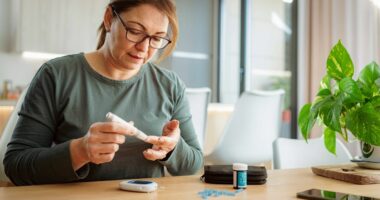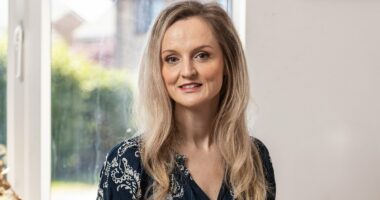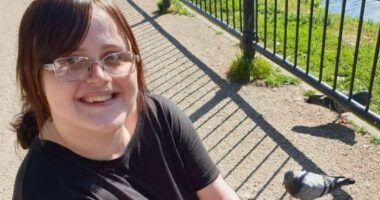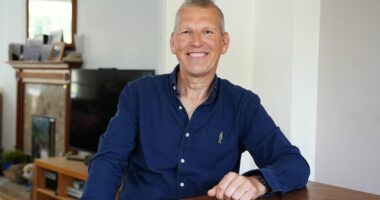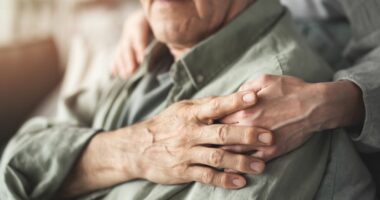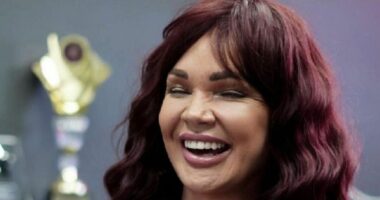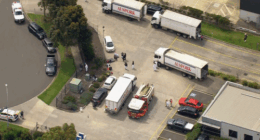Share this @internewscast.com
When Michelle Clark tripped on a concrete step in November 2018 she put it down to clumsiness. But within hours, the mother-of-two was in excruciating pain and practically immobile.
Hospital scans revealed Michelle, then 56, had fractured her right kneecap. Doctors applied a cast and told her to rest, expecting it to heal after eight weeks.
It wasn’t until almost a year later, however, when she broke her right hand while out walking her dog, that the true cause of her repeated injuries came to light.
She was diagnosed with osteoporosis, the brittle bone disease that affects 3.5million Britons and causes bones to become fragile and break more easily – and affects women much more than men.
However, the diagnosis didn’t come from the clinicians who treated her hand.
Instead, it was Michelle’s children who urged her to push for a DEXA scan – a specialist bone-density test that diagnoses osteoporosis – after seeing how quickly she’d suffered a second fracture
Without their intervention, Michelle, who lives with husband Jim, 68, a retired businessman, in Warwickshire, believes she could have gone undiagnosed for years – or until her next, potentially life-threatening, break.
Now 62, she says she is still baffled that no medic diagnosed her sooner – even as one doctor joked she had managed to fracture a ‘really difficult bone to break’.

Michelle Clark, 62, suffered two serious bone breaks before her osteoporosis was picked up. (Pictured: Michelle with her husband Jim)

Michelle’s children urged her to push for a DEXA scan – a specialist bone-density test that diagnoses osteoporosis – after seeing how quickly she’d suffered a second fracture
Michelle is one of tens of thousands of women in mid-life – and younger – who have endured broken bones, and years of pain and frustration, before receiving a diagnosis and treatment.
The NHS recommends any adult over 50 who suffers a ‘fragility’ fracture – a break from a fall at standing height or less – should be assessed for osteoporosis, yet this frequently does not happen.
A 2021 report by the Royal Osteoporosis Society (ROS) found many women in their 50s and early 60s are dismissed or misdiagnosed. And the All-Party Parliamentary Group on Osteoporosis and Bone Health reported in 2023 that tens of thousands of women are missing out on timely diagnosis and treatment.
One major reason cited was age bias. Clinicians often overlook osteoporosis in younger, postmenopausal women despite it being the most likely cause for fragility fractures.
Michelle is speaking out as part of The Mail on Sunday’s War On Osteoporosis campaign.
We are calling on the Government to ensure every part of the UK is served by a specialist clinic, known as a fracture liaison service (FLS), to screen patients for the condition after a break.
While FLS units are in place across every hospital in Scotland, Wales and Northern Ireland, only around half of hospitals in England offer this vital service.
Last year Health Secretary Wes Streeting vowed that one of his first acts in government would be to task the NHS with a ‘rollout plan’ for nationwide access to FLS units. Only in February did he say it would be implemented by 2030.

Without her children’s intervention, Michelle, who lives with husband Jim in Warwickshire, believes she could have gone undiagnosed for years

At the age of 62, Michelle says she is still baffled that no medic diagnosed her sooner – even as one doctor joked she had managed to fracture a ‘really difficult bone to break’
Experts warn every month of inaction on fair access to an FLS puts more lives needlessly at risk.
Broken bones are the fourth leading cause of disability and premature death in the UK and the second biggest cause of adult hospital admissions. Hip fractures, often caused by untreated osteoporosis, claim the lives of an estimated 2,500 Britons every year – deaths that campaigners insist are largely preventable.
The condition affects men, too, but eight out of ten patients are women as a result of hormonal changes that occur during the menopause altering bone density.
‘My diagnosis was a blur,’ recalls Michelle. ‘I knew absolutely nothing about osteoporosis and I was absolutely gobsmacked. I’m a keen walker and gym goer – suddenly I felt vulnerable and old.
‘But what shocked me more was my DEXA scan showed I’d also unknowingly fractured my spine.’
At 54, two years before her kneecap injury, Michelle slipped on her stairs, landing on her back.
‘That fall must have been to blame for the spine fractures,’ she says. ‘I was in agony, but after a few days I just carried on as normal, took painkillers and learned to live with it.
‘My osteoporosis was missed repeatedly. If there had been a local FLS maybe it could have been picked up before I broke another bone.’

Michelle is one of tens of thousands of women in mid-life – and younger – who have endured broken bones, and years of pain and frustration, before receiving a diagnosis and treatment (Stock Image)
When signs of the condition are spotted in FLS, patients are given bone-preserving drugs that more than halve the risk of breaks.
Experts say the FLS ‘postcode lottery’ is putting people at risk.
In March, analysis by this newspaper found nine of the ten areas with the highest rates of over-65s with hip fractures do not have an FLS in their hospitals.
‘Patients are being let down, it’s completely unfair,’ says Emma Clark, a professor of clinical musculoskeletal epidemiology at the University of Bristol.
‘They deserve consistency – their postcode shouldn’t determine the treatment they get. Patients will slip through the cracks.
‘The clinics are not just about ensuring they get bone-strengthening medicines. They also give tailored diet and lifestyle support.’





